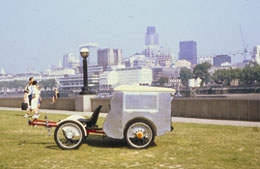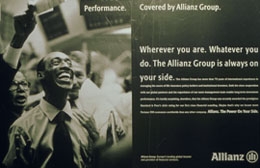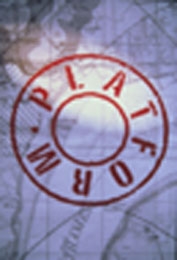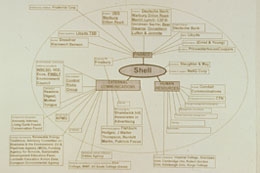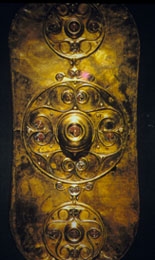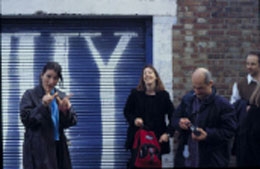
Platform and friends: (l-r) Jane Trowell, Cameron Cartiere, Seyed Alavi, James Marriott. Not pictured: Platform member Dan Gretton
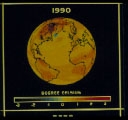
90% Crude (detail), 1996-present ?± Images of the Earth’s climate change from 1870-2080 (produced by the U.K. Government Meteorological Office)
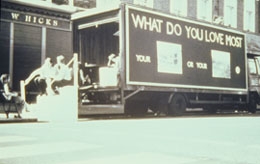
Homeland (1993), mobile installation and discussion space at the London International Festival of Theatre
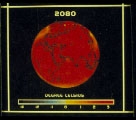
90% Crude (detail) (1996-present) images of the Earth’s climate change from 1870-2080 (produced by the U.K. Government Meteorological Office)
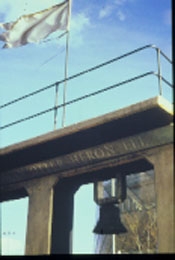
Delta (1993), view of the micro-hydro turbine that generates power to ring the tidal bell and light nearby St. Joseph’s School; stone carving and flag celebrate the sacred past of the inner city river

Killing Us Softly (2000), image from 'Observer' newspaper, 1/6/97 crystallising the banality of corporate evil (detailing Allianz’s business in the 1940s)
Feature: Conversations
A Conversation with Platform
The Political is Personal
While in London during May of 2001, I spoke with Platform, a trio of visionary artists — Dan Gretton, James Marriott, and Jane Trowell. A leading European exponent of Social Practice Art, since 1983 Platform has been involved with the politics of places, particularly as pertains to the continuity of history. Utilizing conversation, storytelling, and walking to envision solutions to social and ecological problems, their work is motivated by an optimistic belief that changes for the better are possible. Deeply inspired by Joseph Beuys, the form and content of Platform’s work fuse the political with the personal.
Their headquarters on the Thames is at the foot of Tower Bridge, and a central aspect of Platform’s work is the remarkable network of rivers integral to the history and commerce of London. Since 1996 they have been involved with 90% Crude, a self-described “journey” comprised of eleven projects investigating the impact of transnational corporations on individuals, the environment, and society at large. Although Platform’s projects take place in London, they have presented their work and established critical dialogues in Europe, Canada, and the US.
Terri Cohn: How do you work together? Do you have different roles in the group?
Dan Gretton: I co-founded Platform with James in 1983 when we were at university and involved in political activism, particularly the anti-nuclear movement of the 1980s. Platform started with our wanting to bring together the energy of activism with the imagination of theatre and performance. To a certain extent, I think that’s still true today. Art, environment, and politics are the three zones of constituency of Platform. At the moment I’m doing a long piece of work called killing us softly, about the psychology of genocide, that looks at individuals within corporations today and the planners and bureaucrats who really organized the Holocaust.
TC: Is that work independent of Platform?
DG: No. The inquiries started maybe fifteen years ago, but the past few years it’s actually become connected to Platform’s work. We started a project called 90% Crude in 1996 looking at the deep culture of transnational corporations and trade. I began to make links with what had been a personal area of inquiry, thinking that there are so many connections with this story of transnationals if you look at it historically. Through my research I’ve been drawing parallels.
Jane Trowell: I’m the newest member of the group. I met Dan at university, in 1983 — it’s actually quite a good story. He knocked on my door because I played the violin and had a Campaign for Nuclear Disarmament badge. He figured I was some sort of politically motivated musician. He introduced himself and asked me if I wanted to join this group called Platform. He told me all about it, and I said, “Absolutely not. You’ve got the wrong person.” The basis was quite agitprop, very bold work — in the street, public-space-type of work — which I admired, and still do — but I just didn’t think it had anything to do with who I was inside. But after five hours of me saying no, we became friends.
DG: It was just an excuse to have a conversation, really.
JT: Cunning! Dan and I became very good friends and eight years later I became involved with Platform. I always found it difficult to categorize the work, but thought it had its own category. It’s part debate through the arts, part political agitation, part very personal, which I found interesting because a lot of activism in the 1980s was about mass culture. There was a fusion between personal issues and political issues that I admired. One day, Dan very cleverly showed me a book cover of a beautiful painting of the meeting of two rivers in a city. He asked me where I thought it was, and I guessed places — Venice, Bruges — which were all wrong. Then he told me it was London three hundred years ago, and I was in; I was hooked. He then told me Platform was doing a project about water in the city and the burial of the Thames tributaries in central London. He asked if I was interested in working on that project as a collaborator, and I had no doubts that it was the right project for me. It’s a serious point because I have some existential problems with political action.
TC: Does that become incorporated into the process? Can you address your issues with political action through the work?
JT: Yes. I think one of the benefits I’ve gotten from working with Platform is experiencing the consensus model, which is extraordinary. It shouldn’t be extraordinary, but it is. It was like dog-eat-dog in the 1980s in England. It still is a brutal environment for active democratic models. So when I started working with Platform I was amazed at the idea that people can sit around and discuss their concerns, and not take a vote, which always used to alienate me about other politics.
DG: We’ve never taken a vote about anything in eighteen years. If there’s a profound disagreement, we’ll take seven hours to sort it out, or however long it takes. It’s expensive in time, but it’s very good in terms of the spirit of the organization.
JT: This approach is not for everybody, but for me it remains a very important reason to be involved.
James Marriott: It’s an intriguing thing, this question of background. I started out in theatre. But I became disillusioned by what I would say was the problem of representing change or revolution, or acting in change or revolution. There was a whole culture in the 1980s doing very radical plays, but the only change that happened was on the stage. That became, for me, a real conundrum. I found myself wanting to see whether it’s possible to make theatre in a way that is actually engaged in real life, so you can balance the poetics of the stage with the pragmatics of the change in the human being in real space. I think a lot of what Platform does is point out the tension between those two things. As Dan was saying, it was a fusion of those two things: the imagination of theatre or art with the action of politics toward change.
Another important thing about that historical moment was the tangibility of the immediate. Student politics of the time tended to focus on the issues of “elsewhere.” The invasion of Grenada was a big example of this. But we were interested from the very beginning in what is happening right here on this street, in our place. We wanted to create works that, right from the first instance, were involved in the immediate, in the local; to use that as a lens through which to see wider issues. It’s there that you can involve yourself in change. All the people involved in the work right from the beginning had a real commitment to what they were doing. I think this has remained important to the present.
TC: You mean your dialogue within the group?
JM: Yes. The necessity to have that is part of the outward form, which is reflected in the inner form of how we work. We all feel strongly committed to the ideas that are the basis of what we do, and we can argue them strongly. The only other twist about us is that I shifted away from theatre toward visual arts; I went back to college and trained as a sculptor. I draw my understanding quite a lot from the essence of sculpture, which is the forming process — the idea of trying to create form, trying to create structures — images — which give form to things which have hitherto been formless. Studying the works of certain artists, like Joseph Beuys, has also been important to the work Platform does because of his ideas about sculpture and art’s relationship to politics, and how politics itself could be made into a sculptural form.
TC: What form do your works take?
JT: Basically, the content of the work seems to evolve through process, which includes internal communication. The themes arise from issues that won’t go away. The forms also arise from what seems to be the most powerful way of getting this message out, or getting this sensibility into the world, or communicating with people. I’ve got one friend and collaborator who often teases us — “You make it difficult for yourselves because every time you do something it’s a different form.”
TC: It sounds like you work with whatever form suits the idea. In the States it’s what we call Conceptual art. Conceptual artists work with whatever form manifests the idea.
JM: What we’re doing is thinking up the ideas. The process of creating an idea — of coming to an understanding and thinking, “how can we create something that provokes change?” That’s the real work… to the point where we’ve churned it over enough that out comes a form, and the form looks like, say, a newspaper. Or the form looks like a performance, a piece of hydrotechnology, a score of contemporary music, or a performance in a dark space for five hours with eight members of the audience. The forms are just the outward expressions of this stuff that we’re working on. The essence of this is democracy, ecology, and interdisciplinary creativity. What we’re trying to do is to find ways to provoke democratic change, ways of improving the relationship between humanity and nature, making a more ecological balance. The technique to do that is by using lots of different disciplines and forms.
DG: There’s this phrase in use the past few years, “Social Practice Art,” that’s come out of the Littoral network [note: there have been two major Littoral conferences so far: the first in Manchester, England, Fall 1994; the second in Dublin, Ireland, September 1998]Öwhich is the space between the high tide and the low tide. Coming back to the image of water, this idea of a moveable space — a space that changes — there’s a network of arts groups worldwide, organized by a group called Projects Environment, that develops Social Practice Art, in which we can feel connected.
JT: I think the methods do provoke some interesting situations. The overall political intent of the work is something we discuss together as a core, sorting out how much we agree on, and do we agree enough and with enough passion to move forward in that direction? Within that there are many ways of operating. Sometimes two of us will collaborate; sometimes we’ll seek partners to collaborate with.
TC: Do you mean from the outside?
JT: Yes. For 90% Crude, this long-term project, there have already been seven smaller projects, each one with a budget and impact, trying to untangle and raise questions in a sustainable way about corporate culture. We think that our place is to create space for in-depth exchange. James is collaborating with a corporate researcher and activist-analyst on a project called Gog and Magog about Shell and BP, two major oil companies that are British, based in London. It’s very interesting — a lot of people who come to the events we stage might know that we have this thing about art, but a lot of people in corporations, as well as direct action activists and transport activists, probably just think, “Oh, it’s that strange group.” For 90% Crude, we decided to work with a campaign journalist to create a commuter newspaper for London. It was a direct imitation of a recently dead commuter paper called Tonight, with exactly that kind of masthead. The idea was that people would say, “Oh, its back!” It’s read by absolutely everyone and we thought, “Let’s take that opportunity!” It’s all about oil and human rights, and we distributed it on December 10, 1996, which is Human Rights day. We got rid of 12,000. We could have got rid of double, if we’d had them!
DG: And it was partly paid for by the Arts Council of England!
JT: That newspaper was a hard-nosed environmental newspaper, saying, “This commodity is fucking up the planet and fucking up the people on the planet.” One year later we brought out one that was about climate change, timed to come out during the Kyoto conference. That one was very, very hard nosed. Interestingly enough, after that we had the most inquiries we’ve had by environmental campaigners! The arts aspect of our work can buy us space.
JM: I think it’s really important to be able to do things that are completely crazy by any other standard. There’s this project, Delta, which is about an area of the mouth of the river Wandle. It’s very polluted, very degraded, but many people care about it. What we decided to do was make a piece of work that would provoke people to think about the fact that this was a river of incredible physical power, because it was a milling river for a thousand years, and has inspirational or spiritual power, because along its length were sacred sites. It came from Christian holy wellsprings. Now, when you walk there you see that it’s black for most of the year from the road runoff, it’s full of shopping trolleys, tires, cans — it’s totally disregarded. We wanted to stick a little micro-hydro turbine in there and generate some flow in the river to light a nearby school.
The idea of doing that is completely bonkers, frankly. If you come at it from the point of view of economics, it’s extremely expensive. If you come at it from the point of view of hydro engineering, it’s also really stupid, because the flow rate of the river is tiny. But if you come at it from the point of view that it needs to be done, in and of itself — just as sculpture needs to be done, in and of itself — then all those things can go out the window.
DG: Sometimes you can ambush people because they don’t quite know what you are if you say you’re an arts group. We had an example of that recently while researching the role of corporations in the Holocaust (as part of killing us softly). We visited a company called Saurer in a little town in Switzerland that manufactured the gas trucks that were used. We got an interview with their corporate communications spokeswoman, saying, “We’re an arts company from London.”
We managed later on in the interview to present information to her about her company’s role in the Holocaust. She was absolutely horrified by it; she had never seen it before. But we had our foot in the door. If we had said we were historical researchers, she wouldn’t have touched us with a barge pole.
JT: Art lets us think in uncommon ways, and the capacity to think in uncommon ways is what is interesting about collaborating beyond the arts.
DG: The success of that model of working gave us courage. For the Still Waters project we worked with a senior psychologist at The Royal London Hospital, and we worked with someone who did publicity. With the Homeland project we worked with an economist who did research for six months. What was interesting about it is that you have to change your language — you find something that is not actually in any of your languages. It represents a kind of dialogic model, the relationship that we want to have with audience. We got funding last year for the project I’ve been working on, killing us softly, because we said we want to work with psychologists to interview people in corporate management, to see how they can continue “functioning” in a corporation; what are the ethical dilemmas they face? This collaboration is going to feed into the performance; it underpins a lot of our practice. When we’re working on a new project, we think about what discipline we want to work with that would really expand this work.
TC: I’m curious, how did you choose your name?
JM: It came out of the first thing Platform ever did, which was a kind of group gathering. A whole range of people interested in the idea of political theatre came together. One person said, “Let’s call it Platform.” It was a mixture between a political platform and the stage. It’s funny, people have often asked us why we don’t change our name, but I think its ambiguity has acted in our favor because people don’t know what we are. Some people think we’re an oil research organization focusing on platform security!
TC: With that said, I’m interested in hearing about your methodology. I notice you’ve written three manifestos; it’s clear that you must have a methodology that’s central to your work.
DG: In the past year, we’ve been rethinking the theory behind the work, and as we approached twenty years doing it, we came up with something we call “the three Ps,” which stands for production, pedagogy, and process. We’ve tried to create new ways of looking at everything we do in those categories. Production is what’s in the public domain in terms of performance, street-based work, or a walk. Pedagogy is a rather heavy word in our culture with rather negative connotations, but it also has a radical history. In the past five years, education work has been a big influence on the way Platform does events; what we call “engaged pedagogy.”
JT: It’s a kind of activism, an eyeball-to-eyeball way of working with people.
DG: Process has been the most interesting aspect for us to represent. That’s the most ephemeral thing. Process is everything about the network aspect — the conversations we have with people, the e-mail, and visiting people. We’ve done a lot of international work with groups in Eastern Europe, Central Europe, Canada, and a little bit in the States. The process is as important as production and pedagogy. It’s the heart or bloodstream of the body: you wouldn’t have any production, you wouldn’t have any pedagogy, if it weren’t for process. I think it gives a kind of intimacy to our work because everything we do starts with a conversation.
TC: I appreciate that because it seems to fit with the kinds of issues you take on, like water and nature. Time in nature is very slow; things don’t change very quickly if nature is left to its own devices. There’s something that seems to match the process here — or intersects with the truth of the world if we left it alone.
JM:The more we go on, the more we find that time is a medium we’re using, and slowness is a strategy that has become really important to us.
DG: We came up with three little lines recently which describe our work in the City of London [the financial district of London]:
Meet the speed of the city with slowness
Meet the concrete of the city with nature
Meet the anonymity of the city with intimacy
For our project on transnational trade, we’ve got to move more slowly and more intimately than it does. If you try to mimic that world, you’ll just disappear in a puff of smoke.
TC: Another interesting feature of your work is your deep interest in words and etymology. Could you just address that a bit?
JT: We think conversation is essential, having been under eighteen years of one party rule. Conversation kept you going in such arch-conservatism as the Thatcher and Major governments. Especially when you feel that the government is managing to harness a populist rhetoric, which is terrifying. Conversation has been seen as a subversive activity necessary for mental health
DG: I think that’s the thing we’re probably most criticized for. Although a conversation might seem very democratic, the question you have to ask is, “who is around the table?” Or to put it another way, “who is not around the table?”
TC: What about your relationship to the city? It seems that walking is a major activity in your work.
JM: Increasingly we’ve tried to utilize walking as a means by which other people can also embody the critical process. I think a good example is Gog and Magog. Gog and Magog is about trying to explore the nature of a contemporary corporation. What is this thing? What does it do? What is its impact on the world? How are we already inside it?
One of the ways in which the work manifests itself is through a day-long event. People arrive here at ten o’clock in the morning. They view a presentation that explores the various impacts of BP and Shell on ecology, democracy, and justice. We also explore the companies’ structures, and point out how the members of the audience are already members of the structure, even though they may not be part of BP and Shell. Then we go out into the city and walk to buildings for three hours. Through that process, they physically get to see how all these different organizations fit together. Through the traffic and the heat on the soles of their feet, they embody the nature of corporate reality, and I think that’s incredibly important.
DG: There’s a wonderful line from the Swedish writer Sven Lindqvist, whose book Exterminate the Brutes has had a great influence on our thinking. It’s about the relationship between knowledge and experience. It begins, “You already know enough. So do I. It is not knowledge we lack. What is missing is the courage to understand what we know and to draw conclusions.” In a world where there is so much information and things are moving so fast, to get people to experience something on this level is very important to us. Whether it’s by walking through cities, such as Jane is doing with the Fleet River now, or whether it’s through people coming to a day event, it’s about seeing somebody’s face, it’s about being in a darkened space, it’s about the music you hear coming through. The walking aspect is something we’ve always done, instinctively. Years later someone can make a theory out of it, but for us it’s always been a practice because it’s where we start.
JT: It’s the notion that something is really there beyond just a site visit. Something about it is much greater than you: it’s been there longer than you, it’ll be here long after you, it’s seen everything at least five times, especially in a small packed country like England.
JM: One of the things that’s really important for us is the sense of place, the locality of where we are. When we stand up and talk about what we do, we say that we do work in our own home, which is London — the tidal Thames ground — and that’s got something to do with time. We’re saying, “okay, let’s look at this place; let’s think about this place through time vertically. At one point, this place, this location right here underneath where this carpet is, existed for thousands of years before human beings set foot on it. It has the point at which it became settled, it has the point at which it was an island with a Norse name, Beormond’s Ev (today Bermondsey, an area of south London), it has the point where the first plow covered it. Layer upon layer upon layer existing on this point, and we need to understand that and draw that, like a well, into our understanding, in order to understand what the hell the future is about.” That, I think, is incredibly rich. What we’re going to do is work in this place over a long period of time to try to find new ways of making work about this; to reinvigorate people about this, to re-imagine this place over a long period of time. Capitalism is built on immediacy. Building an understanding of the past is a powerful form of resistance against that.
DG: John Berger, the critic, has this amazing line at the end of Pig Earth, an historical afterword, where he says, “The historic role of capitalism itself is to destroy history, to sever every link with the past, and to orientate all effort and imagination to that which is about to occur. The metaphysic of capital exists only in regard to future expectation and credit. History is bunk. Destroying the presence of the world could be a final act of historical elimination.” The corporate research we’ve been doing shows the ways that history is just shredded by corporations, which don’t want you to understand the past. These people do not even want to have a conversation about it.
TC: I see an example of this idea in your Still Waters campaign, about the river’s loss of voice and the analogy with the human voice; the idea of dysphonics.
DG: One of the psychologists we worked with was a specialist in aphonia, which is trauma suffered by people resulting in the loss of voice. He did a whole piece with an artist that was based on the river that goes under the Bank of England. They made a kind of shed with an installation comparing persons who had a trauma and loss of voice with the forgottenness of this river, which has been tarmacked over since Roman times. The very act of speaking some of these rivers’ names again has been an amazing process. It’s bringing the rivers back on people’s tongues and in people’s imaginations. The idea of walking down a street that is not a street but a river and in the end, will be a river again, that’s an amazing sense. Those rivers are still alive. They’ve been temporarily underground, but you’ll never get rid of a river. Maybe all political change is, after all, an accumulation of thousands of stories being told to one another, people having conversations and telling each other stories, which forms a desire, which leads to a change.
TC: It’s like developing world views; that’s how it happens.
JT: I wanted to add something about language. When I was first with Platform, Dan and I made some reading lists. One of the books was H2O and the Waters of Forgetfulness by Ivan Illich. He wrote about the Greek muses and their mother, Mnemosyne, whose name has gone out of popular parlance; we only know it through the word mnemonic. She was the goddess of memory, and it was to her well that people would go, seeking inspiration. They would look into the waters of her well and they would receive inspiration from those water. What’s interesting about that is there are so many Greek gods floating around in popular culture — even Nike is a Greek god! But the goddess of memory, related to water, has vanished. There’s a reason why these myths are so powerful, and there’s a reason why some myths are forgotten. It doesn’t fit capitalism to stare into a well and receive some kind of self-knowledge and inspiration and creativity.
JM: Memory is profoundly political.
JT: Just listening to this, I realize that storytelling is such a simple thing, isn’t it? We’ve never really spoken about that as a term in our work, but I think it is a strong term. More than any other project we’ve done Gog and Magog is a storytelling session. The walks are storytelling. I’m creating a concept whereby people who want to create a walk to the financial center of London for whatever reason can come together and discuss that with other people that might have very different motives. Average folks can create, in physical process, a storytelling in walking.
JM: It seems to me that stories are an instrumental form of truth, a representation of truth which enables you to cope with the world. There are power structures that are constantly trying to stop you from creating stories about them, but stories are a means of excavating reality. The graph in Gog and Magog is a representation of a share price of Shell over a period of time. For most of us, it’s completely obscure, but we try to set it up in such a way that when somebody’s looked at that and we’ve told several stories about it, they can walk away from it and tell that story to others.
Platform can be reached via email at: info@platformlondon.org
Portions of this interview first appeared in Sculpture.

